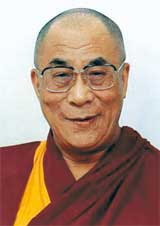Dalai Lama main influence in TCVs

'He is the head of the Gelug School of Lamas, one of four prominent Tibetan Buddhism Schools
'He earned a Nobel Peace Prize in 1989
'His birth name is Lhamo Dhondrub
The Dalai Lama
Thupten Dorjee, General Secretary of the Tibetan Children’s Villages utilizes the words and teachings of the Dalai Lama in his analysis of the desire for peace that distinguishes the Tibetan people.
“Science and technology have advanced so much, but the human mind has not,” Dorjee said when questioned as to how the desire for peace and the method of nonviolence is perpetuated among the youth of the Tibetan culture.
Dorjee said the Dalai Lama is concerned “not only with the Tibetans, but with the entire human race.”
Dorjee quoted His Holiness in saying that “Globalization is increasing, which leads to interdependence, which requires communication in situations of conflict, which can be non-violently resolved.”
The Tibetan people have a 2,000 year history of peace.
“Following the spread of Buddhism, the warrior nature was tamed,” Dorjee said.
In Tibetan culture, the family and the Buddhist teachings form the base upon which a life is built. Buddhism and the Buddhist teachings are believed to be directly responsible for the non-violent nature of Tibetan culture.
In the TCVs, the students are heavily influenced by the teachings of the Dalai Lama. No specific curriculum in the TCV school system is given for non-violence or Buddhism. Historical and ethical values of Tibetan culture, with inherent Buddhist influences are taught in the Tibetanization program and extra-curricular non-violent programs are encouraged.
Students in the TCVs are taught first that they are Tibetan. Dorjee believes the “Tibetan culture will be preserved in exile through education.”
Educators are well aware that once a student graduates, matures and becomes an adult member of the Tibetan community, he will have to shoulder the responsibility of the occupation of Tibet. Both principle and practicality dictate that the approach is non-violent.
The exiled youth of Tibet, under the guidance of His Holiness, have determined that a dialogue must be initiated with the Chinese. While Tibetans refuse to give up hope that their country will be returned to them, the newest generation of political activists have become infinitely more moderate in tactic. His Holiness now desires to engage in a discourse with the Chinese, so he may suggest a new resolution: viable autonomy for Tibet as a territory of China, as opposed to the complete independence he has demanded in the past.
Your donation will support the student journalists of Missouri Southern State University. Your contribution will allow us to purchase equipment and cover our annual website hosting costs.



























